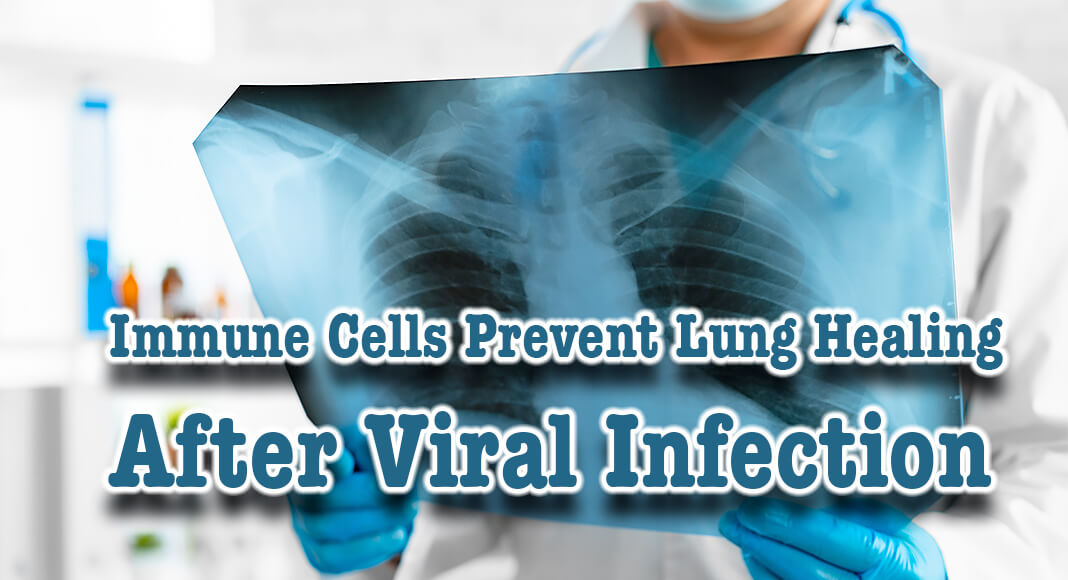
Mega Doctor News
Newswise – LOS ANGELES – Investigators involved in a multicenter study co-led by Cedars-Sinai discovered a pathway by which immune cells prevent the lungs’ protective barrier from healing after viral infections like COVID-19. The findings, published in Nature, may lead to new therapeutic treatment options.
The COVID-19 pandemic revealed how viral infections can cause long-lasting effects—a condition called long COVID. Also known as post-acute sequelae of SARS-CoV-2, long COVID has left a devastating trail of people who continue to live with long-term debilitation after infection. One such manifestation is scarring of the lungs—a condition known as post-acute sequelae of SARS-CoV-2 pulmonary fibrosis.
Those with long COVID can present with a broad constellation of symptoms, including post-acute sequelae of SARS-CoV-2 pulmonary fibrosis, which can cause severe difficulty breathing that requires oxygen supplementation. Patients with the most severe breathing difficulty may also need a lung transplant. Without additional treatment options, many patients are often left with long-term disability and life-threatening complications.
“This study sought to understand the pathways that led to abnormal repair in the lungs that produced a scar-forming environment,” said Peter Chen, MD, co-corresponding author of the study, the Medallion Chair in Molecular Medicine and the interim chair of the Department of Medicine at Cedars-Sinai. “Our findings may lead to therapeutic strategies to prevent fibrotic lung disease after viral illnesses.”
Investigators established models of post-viral lung disease and used molecular profiling and imaging to identify immune cells called CD8+ T cells as a driving factor in preventing lung healing and repair post-infection. Moreover, the investigators used post-acute sequelae of SARS-CoV-2 pulmonary fibrosis patient cohorts to validate the abnormal immunologic pathways, corroborating the animal model work.
“Although we based the work on post-acute sequelae of SARS-CoV-2 pulmonary fibrosis, other viral pandemics in the past have also revealed that ability to cause lung scarring after infection—like swine flu,” said Jie Sun, PhD, co-corresponding author of the study and professor of Medicine at the University of Virginia School of Medicine. “The research and broader medical field must be prepared and better understand how to prevent adverse outcomes stemming from these viruses.”
Chen and Sun say these findings—and similar studies—could provide novel information into the pathobiology of other forms of lung fibrosis.
Other Cedars-Sinai authors include Tanyalak Parimon, Changfu Yao and Alberto Marchesvsky. Additional authors include Harish Narasimhan, Su Cheon, Wei Qian, Sheng’en Shawn Hu, Chaofan Li, Nick Goplen, Yue Wu, Xiaoqin We, Young Min Son, Elizabeth Fink, Gislane de Almeida Santos, Jinyi Tang, Lyndsey Muehling, Glenda Canderan, Alexandra Kadl, Abigail Cannon, Samuel Young, Riley Hannan, Grace Bingham, Mohammed Arish, Arka Sen Chaudhari, Jun sub Im, Cameron L.R. Mattingly, Patcharin Pramoonjago, Jeffrey Sturek, Jacob E. Kohlmeier, Yun Michael Shim, Judith Woodfolk, and Chongzhi Zang.
The study was in part supported by the US National Institutes of Health grants AI147394, AG069264, AI112844, HL170961, AI176171 and AI154598 to J.S, R01HL132287, R01HL167202, and R01HL132177 to Y.M.S, R35HL150803 to J.E.K., Emory Center of Excellence for Influenza Research and Response grant 75N93019R0028 to J.E.K., F31HL164049-01A1 to C.L.R.M., and F31HL170746 and T32AI007496 to H.N.
Read more on the Cedars-Sinai Blog: After Lung Transplant, a Return to Running










